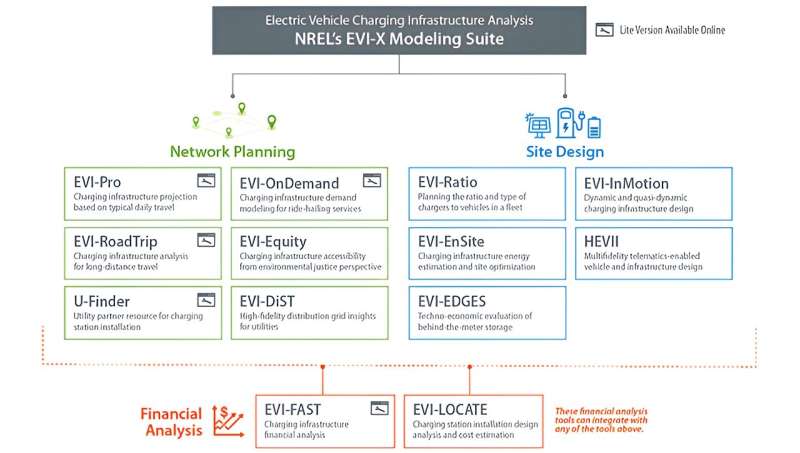
JUNE 18, 2024 by Julia Thomas, National Renewable Energy Laboratory
Collected at: https://techxplore.com/news/2024-06-evi-optimized-electric-vehicle-infrastructure.html
Massive public and private investments are being made to support the buildout of electric vehicle (EV) charging infrastructure in the United States, but efficient planning and deployment requires sophisticated analysis to ensure convenient, reliable, affordable, and equitable charging for all Americans.
This is where the National Renewable Energy Laboratory (NREL) comes in. Leveraging its decades of EV charging infrastructure expertise, the laboratory developed the EVI-X Modeling Suite of EV Charging Infrastructure Analysis Tools, the most sophisticated and comprehensive set of integrated charging infrastructure analysis tools available today.
“Each tool in the EVI-X modeling suite shares the same philosophy: to accelerate convenient and affordable EV adoption by lowering every possible barrier to EV charging infrastructure deployment,” said NREL’s Eric Wood, a senior EV charging infrastructure researcher who plays a key role in developing and refining the suite.
“We’ve added everything we understand about human behavior and charging preferences to simulate what an EV charging network should look like to meet peoples’ needs, whether they drive a small sedan or a heavy-duty tractor trailer.”
“We take the stance that EV adoption needs to be a no-compromise solution,” he continued. “EV charging, as we see it, should be easy, convenient, and never fail to meet drivers’ needs.”
In addition to identifying the necessary number and type of EV chargers—ranging from fast, high-power public charging stations to slower, Level 1 (120 volts AC) and Level 2 (208–240 volts AC) charging ports—to support large-scale EV adoption, the EVI-X suite enables researchers, partners, and others to pinpoint locations best suited for EV charging station installation, estimate associated costs and charging loads, and develop optimal solutions for effective integration—all before monetary and time investments are made.
“While some of the tools in the EVI-X suite were developed years ago, others are relatively new,” Wood said.
“Originally, each tool in the suite was developed independently, but as they matured, we began to realize that linking them together would enable us to answer deeper questions. And today, we can even link tools in the EVI-X suite with other tools in NREL’s portfolio to explore EV adoption scenarios, power systems modeling, and more.”
The EVI-X suite has the unparalleled ability to answer the most complex questions addressing every aspect of EV charging—from network planning and site design to financial analysis—for every vehicle weight class—from sedans and SUVs to delivery vans, buses, freight trucks, and more—and at wide-ranging geographic scales—from a small town to the entire nation. Because it is agile enough to account for changing variables, such as improving EV technologies and growing consumer adoption, the EVI-X suite can provide accurate EV charging analysis for today and in the decades to come.
Three types of tools in the EVI-X suite
The tools in the EVI-X suite fall into three crosscutting categories:
- Network planning tools to quantify EV charging infrastructure needs such as the number, type, and location of charging ports to support different levels of EV adoption; recommended power levels; the potential grid impacts of increasing EV adoption, plus strategies to lessen stress on the grid; accessible and affordable charging; optimized charging for fleets and ride-hailing services; long-distance travel along highway corridors; and finding utility partners for infrastructure installation
- Site design tools to inform EV charging station designs related to energy estimation and site optimization; composition and size of EV fleets; placement of charging station equipment; sizing and control of behind-the-meter energy storage; and the feasibility of dynamic roadway charging
- Financial analysis tools to assess costs associated with EV charging infrastructure such as station and network economics, the levelized cost of charging, and investor payback period and risk analyses.

Leave a Reply